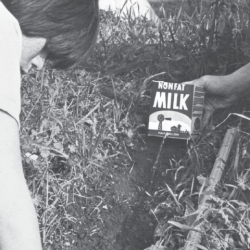Source Institutions
Source Institutions
Add to list Go to activity
Activity link broken? See if it's at the internet archive

In this outdoor activity, learners investigate the relationship between the slope of a trail and soil erosion. Using both math and science skills, learners gain awareness of how human activities such as construction and agriculture can alter the environment and change the rate of soil erosion, affecting plant and animal life as well as changing the landscape and increasing such risks as flooding. This activity can be combined with the Cardiac Hill activity from the same source.
- 1 to 2 hours
- 45 to 60 minutes
- $10 - $20 per group of students
- Ages 8 - 18
- Activity, Lesson/Lesson Plan, Simulation
- English
Quick Guide
Materials List (per group of students)
- one-liter water source made from half-gallon milk carton
- tin-can erosion collector (from soup can, etc.)
- 1 meter tape
- trowel or small digging tool
- 2-4 small plastic bags or cups
- permanent ink makring pen
- water
- 2 slope-measuring devices (see page 5 of PDF)
- 1 or 2 containers of water, a water tap, a hose, or other water supply
- Measuring Slope Equipment Card (see page 5 of PDF)
- data board or large drawing pad
- short pencil (to poke holes)
- pair of scissors
- can opener (to remove can bottoms)
- hammer and 2 nails or wedge-shaped can opener
Subjects
-
Earth and Space Science
-
Earth Structure
- Rocks and Minerals
- Oceans and Water
-
Earth Structure
-
Life Sciences
-
Ecology
- Ecosystems
- Human Impact
-
Ecology
-
Mathematics
-
Data Analysis and Probability
- Data Analysis
- Data Collection
- Data Representation
-
Geometry
- Plane Geometry
-
Measurement
- Rate
-
Number and Operations
- Fractions
- Representation
-
Data Analysis and Probability
-
The Nature of Technology
-
Technology and Society
- Technology and the Environment
-
Technology and Society
-
The Nature of Science
-
Science and Society
- Risks and Benefits
-
The Scientific Process
- The Scientific Worldview
- Asking Questions
- Conducting Investigations
- Gathering Data
- Formulating Explanations
- Communicating Results
-
Science and Society
Informal Categories
- Nature and Environment
- Outdoor Activity
- Physical Activity
Audience
To use this activity, learners need to:
- see
- read
- be mobile
- touch
Learning styles supported:
- Involves teamwork and communication skills
- Uses STEM to solve real-world problems
- Involves hands-on or lab activities
Other
This resource is part of:
Access Rights:
- Free access
By:
Rights:
- All rights reserved, The Regents of the University of California, 1982
